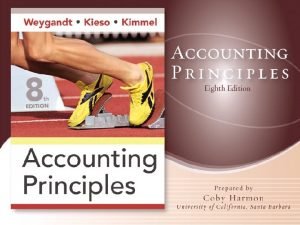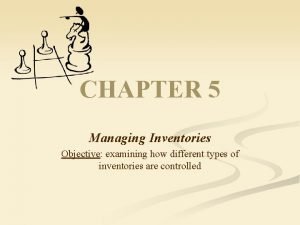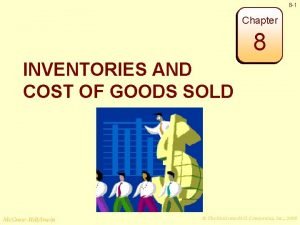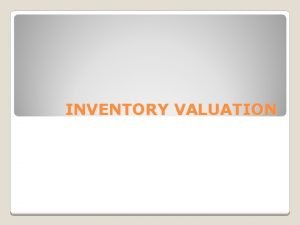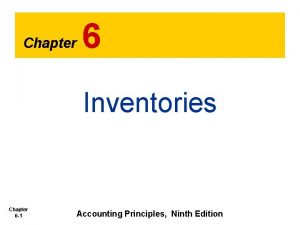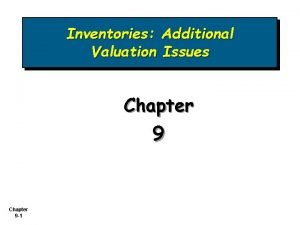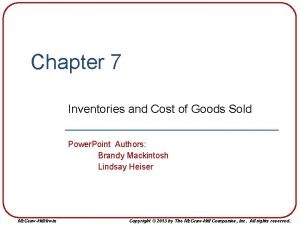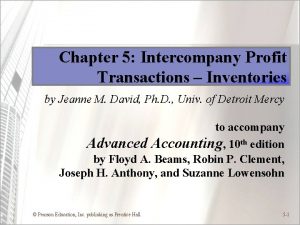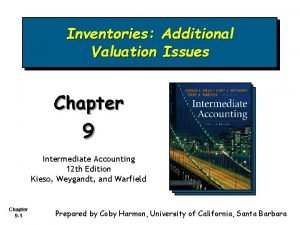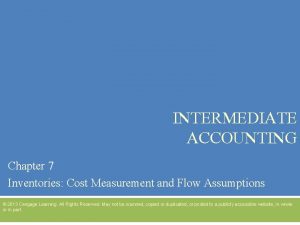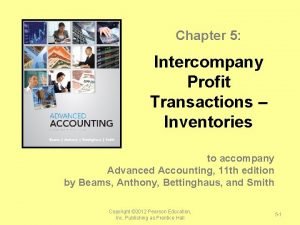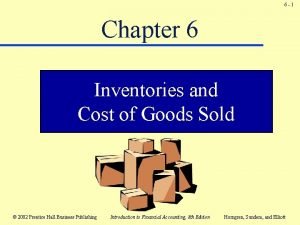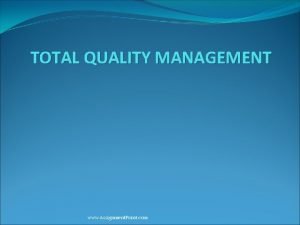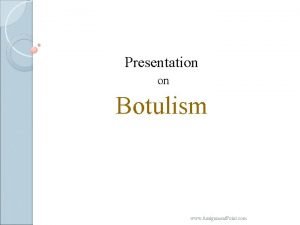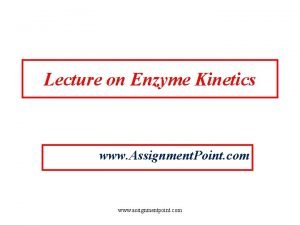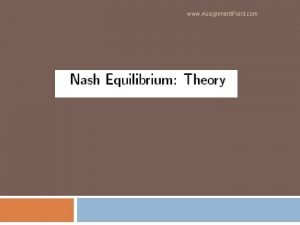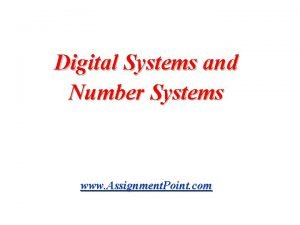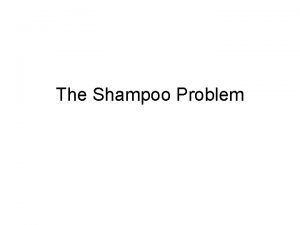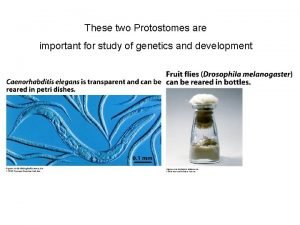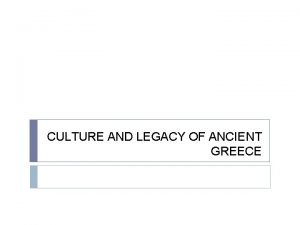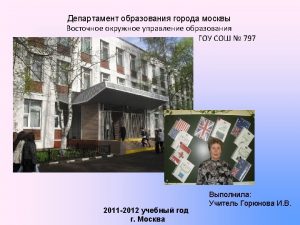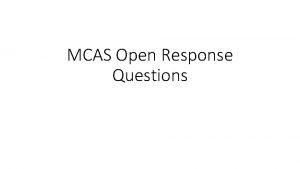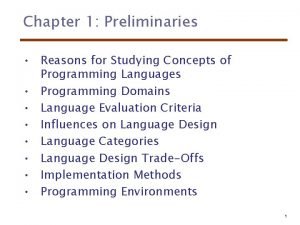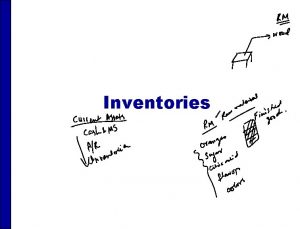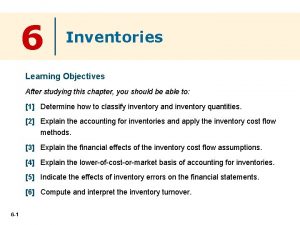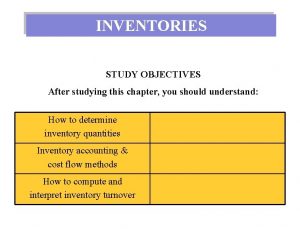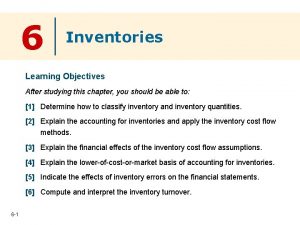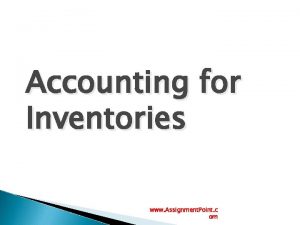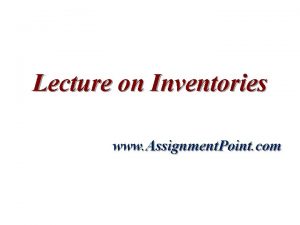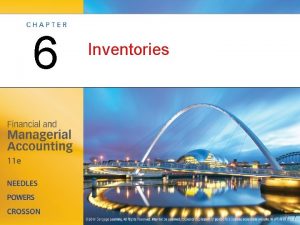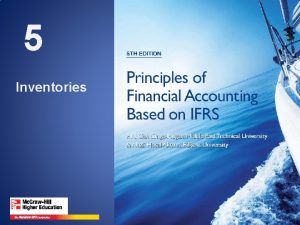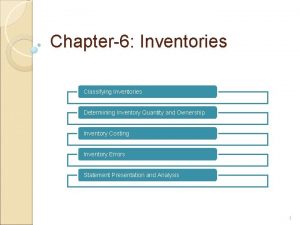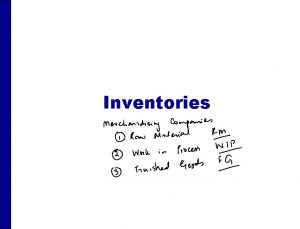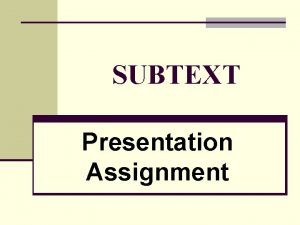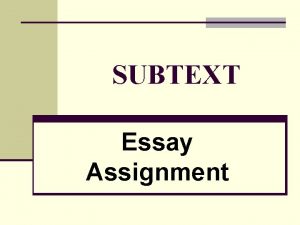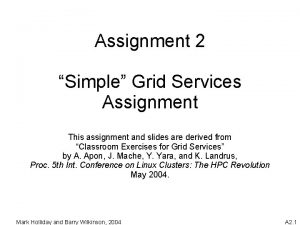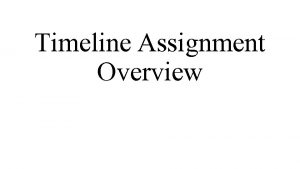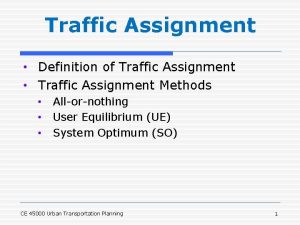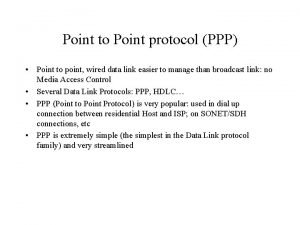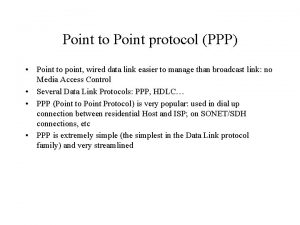Inventories www Assignment Point com INVENTORIES After studying






























































- Slides: 62

Inventories www. Assignment. Point. com

INVENTORIES After studying this chapter, you should be able to: 1 2 3 4 5 6 Describe steps in determining inventory quantities Explain the basis of accounting for inventories and describe the inventory cost flow methods Explain the financial statements and the tax effects of each inventory cost flow method Explain the lower of cost or market basis of accounting for inventories Indicate the effects of inventory errors on the financial statements Compute andwww. Assignment. Point. com interpret inventory turnover

INVENTORY BASICS • Balance sheet of merchandising and manufacturing companies – inventory significant current asset • Income statement – inventory is vital in determining results • Gross profit – (net sales - cost of goods sold) • watched by management, owners, and others www. Assignment. Point. com

MERCHANDISE INVENTORY CHARACTERISTICS Merchandise inventory 1 Owned by the company 2 In a form ready for sale www. Assignment. Point. com

CLASSIFYING INVENTORY IN A MANUFACTURING ENVIRONMENT • Manufacturing inventories may not yet be ready for sale • Classified into three categories: 1 Finished goods ready for sale 2 Work in process various stages of production (not completed) 3 Raw materials components on hand waiting to be used – www. Assignment. Point. com

DETERMINING INVENTORY QUANTITIES STUDY OBJECTIVE 1 To prepare financial statements determine 1. the number of units in inventory by taking a physical inventory of goods on hand physical inventory by counting, weighing or measuring 2. The ownership of goods www. Assignment. Point. com

DETERMINING COST OF GOODS ON HAND 3. apply unit costs to the total units on hand for each item 4. total the cost of each item of inventory to determine total cost of goods on hand www. Assignment. Point. com

TAKING A PHYSICAL INVENTORY Internal control principles for inventory: 1 Segregation of duties counting by employees not having custodial responsibility for the inventory 2 Establishment of responsibility each counter should establish the authenticity of each inventory item www. Assignment. Point. com

TAKING A PHYSICAL INVENTORY 3 Independent internal verification second count by another employee 4 Documentation procedures pre-numbered inventory tags 5 Independent internal verification designated supervisor checks all inventory items tags, no items have more than one tag www. Assignment. Point. com

OWNERSHIP OF GOODS IN TRANSIT • Goods in transit: included in the inventory of the party that has legal title to the goods • FOB (Free on Board) shipping point: ownership of the goods passes to the buyer when the public carrier accepts the goods from the seller • FOB destination point: legal title to the goods remains with the seller until the goods reach the buyer www. Assignment. Point. com

TERMS OF SALE www. Assignment. Point. com

CONSIGNED GOODS Consignment: the holder of the goods (consignee) does not own the goods – ownership remains with the consignor of the goods until the goods are sold – consigned goods should be included in the consignor’s inventory, not the consignee’s inventory Owned by a consignor; do not count in consignee inventory www. Assignment. Point. com Consignee Company

INVENTORY ACCOUNTING SYSTEMS 1 Perpetual • detailed records • cost of each item maintained • cost of each item sold is determined when sale occurs 2 Periodic • cost of goods sold is determined at the end of accounting period www. Assignment. Point. com

Basis of Accounting for Inventories Periodic Cost Flow Methods STUDY OBJECTIVE 2 • Revenues from the sale of merchandise are recorded when sales are made in the same way as in a perpetual system. • No calculation of cost of goods sold is made at the time of sale of the merchandise. • Physical inventories are taken at end of period to determine: – the cost of merchandise on hand – the cost of the goods sold during the period www. Assignment. Point. com

ALLOCATING INVENTORIABLE COSTS • Inventory costs- periodic inventory system – allocated between ending inventory and cost of goods sold – allocation is made at the end of the accounting period 1 the costs assignable to the ending inventory are determined 2 the cost of the ending inventory is subtracted from the cost of goods available for sale to determine the cost of goods sold 3 cost of goods sold is then deducted from sales revenues in accordance with the matching principle to get gross profit www. Assignment. Point. com

COST OF GOODS SOLD Cost of Goods Sold –Review Periodic inventory system Three steps are required: 1. record purchases of merchandise, 2. determine the cost of goods purchased, 3. determine the cost of goods on hand at the beginning and end of the accounting period www. Assignment. Point. com

DETERMINING COST OF GOODS PURCHASED To determine Cost of Goods Purchased: 1 subtract contra purchase accounts of Purchases Discounts and Purchases Returns and Allowances from Purchases to get Net Purchases 2 add Freight-in to Net Purchases www. Assignment. Point. com

ALLOCATION (MATCHING) OF POOL OF COSTS STUDY OBJECTIVE 5 $ 120, 000 $15, 000 $105, 000 www. Assignment. Point. com

The cost of goods available for sale is allocated between a. b. c. d. beginning inventory and ending inventory. beginning inventory and cost of goods on hand. cost of goods purchased and cost of goods sold. beginning inventory and cost of goods purchased.

The cost of goods available for sale is allocated between a. b. c. d. beginning inventory and ending inventory. beginning inventory and cost of goods on hand. cost of goods purchased and cost of goods sold. beginning inventory and cost of goods purchased.

USING ACTUAL PHYSICAL FLOW COSTING • Costing of the inventory is complicated because specific items of inventory on hand may have been purchased at different prices. • The specific identification method tracks the actual physical flow of the goods. • Each item of inventory is marked, tagged, or coded with its specific unit cost. • Items still in inventory at the end of the year are specifically costed to arrive at the total cost of the ending inventory. www. Assignment. Point. com

SPECIFIC IDENTIFICATION METHOD www. Assignment. Point. com

USING ASSUMED COST FLOW METHODS • Other cost flow methods are allowed since specific identification is often impractical. • These methods assume flows of costs that may be unrelated to the physical flow of goods. • For this reason we call them assumed cost flow methods or cost flow assumptions. They are: 1 First-in, first-out (FIFO). 2 Last-in, first-out (LIFO). 3 Average cost. www. Assignment. Point. com

FIFO • The FIFO method – earliest goods purchased are the first to be sold. – often parallels the actual physical flow of merchandise. – the costs of the earliest goods purchased are the first to be recognized as cost of goods sold. www. Assignment. Point. com

FIFO www. Assignment. Point. com

ALLOCATION OF COSTS - FIFO METHOD $ 12, 000 $ 5, 800 www. Assignment. Point. com $ 6, 200

PROOF OF COST OF GOODS SOLD The accuracy of the cost of goods sold can be verified by recognizing that the first units acquired are the first units sold. 100 250 550 $ 10 11 12 www. Assignment. Point. com $ 1, 000 2, 200 3, 000 $ 6, 200

LIFO • The LIFO method assumes that the latest goods purchased are the first to be sold. • LIFO seldom coincides with the actual physical flow of inventory. • Under LIFO, the costs of the latest goods purchased are the first goods to be sold. www. Assignment. Point. com

LIFO www. Assignment. Point. com

ALLOCATION OF COSTS - LIFO METHOD $ 12, 000 $ 5, 000 www. Assignment. Point. com $ 7, 000

PROOF OF COST OF GOODS SOLD The cost of the last goods in are the first to be assigned to cost of goods sold. Under a periodic inventory system, all goods purchased during the period are assumed to be available for the first sale, regardless of the date of purchase. Date Units 11/27 400 08/24 150 Total 550 Unit Cost X X $ 13 12 www. Assignment. Point. com Total Cost = $ 5, 200 = 1, 800 $ 7, 000

AVERAGE COST • The average cost method – assumes goods available for sale are homogeneous. – the cost of goods available for sale is allocated on the basis of the weighted average unit cost incurred. – weighted average unit cost is applied to the units on hand to determine cost of the ending inventory. www. Assignment. Point. com

AVERAGE COST www. Assignment. Point. com

ALLOCATION OF COSTS AVERAGE COST METHOD $ 12, 000 $ 5, 400 www. Assignment. Point. com $ 6, 600

USE OF COST FLOW METHODS IN MAJOR U. S. COMPANIES Companies adopt different inventory cost flow methods for various reasons. Usually one of the following factors is involved: 1) income statement effects, 2) balance sheet effects, or 3) tax effects. 5% Other 21% Average Cost 30% LIFO www. Assignment. Point. com 44% FIFO

A company had the following inventory information for the month of May: May 1 Beg. Inventory 400 units @ $10. 00 = $ 4, 000 8 Purchase 500 units @ $10. 50 = $ 5, 250 20 Purchase 600 units @ $10. 60 = $ 6, 360 Total units 1, 100 $15, 610 Assuming the company is using the Lifo method of inventory: Calculate the value of the ending inventory if there are 100 units in ending inventory on May 31 st.

Under LIFO, the ending inventory consists of the oldest 100 units, therefore ending inventory = 100 units X $10 = $1, 000.

INCOME STATEMENT EFFECTS COMPARED STUDY OBJECTIVE 3 Kralik Company buys 200 XR 492 s at $20 per unit on January 10 and 200 more on December 31 at $24 each. During the year, 200 units are sold at $30 each. Under LIFO, the company recovers the current replacement cost ($4, 800) of the units sold. Under FIFO, however, the company recovers only the January 10 cost ($4, 000). To replace the units sold, it must invest $800 (200 x $4) of the gross profit. Thus, $800 of the gross profit is said to be phantom or illusory profits. As a result, reported net income is overstated in real terms. LIFO Cost of goods sold 4, 000 (200 x $20) www. Assignment. Point. com FIFO 4, 800 (200 x $24)

USING INVENTORY COST FLOW METHODS CONSISTENTLY • Consistency – Companies needs to use its chosen cost flow method from one period to another. – Consistent application makes financial statements comparable over successive time periods. – If a company adopts a different cost flow method: • The change and its effects on net income must be disclosed in the financial statements www. Assignment. Point. com

VALUING INVENTORY AT THE LOWER OF COST OR MARKET STUDY OBJECTIVE 4 • Value of inventory is lower than its cost – The inventory is written down to its market value • Known as the lower of cost or market (LCM) method • LCM basis – Market is defined as current replacement cost, not selling price www. Assignment. Point. com

COMPUTATION OF LOWER OF COST OR MARKET $ 159, 000 www. Assignment. Point. com

INVENTORY ERRORS - INCOME STATEMENT EFFECTS STUDY OBJECTIVE 5 • both beginning and ending inventories appear on the income statement • ending inventory of one period automatically becomes the beginning inventory of the next period • inventory errors – affect the determination of cost of goods sold and net income www. Assignment. Point. com

FORMULA FOR COST OF GOODS SOLD Beginning Inventory + Cost of Goods Purchased _ Ending Inventory = Cost of Goods Sold the effects on cost of goods sold can be determined by entering the incorrect data in the above formula and then substituting the correct data www. Assignment. Point. com

EFFECTS OF INVENTORY ERRORS ON CURRENT YEAR’S INCOME STATEMENT Understate beginning inventory Understated Overstate beginning inventory Overstated Understate ending inventory Overstated Overstate ending inventory Understated Overstated An error in ending inventory of the current period will have a reverse effect on net income of the next period. www. Assignment. Point. com

ENDING INVENTORY ERROR BALANCE SHEET EFFECTS the effect of ending inventory errors on the balance sheet can be determined by the basic accounting equation: Assets = Liabilities + Owners Equity www. Assignment. Point. com

ENDING INVENTORY ERROR BALANCE SHEET EFFECTS Errors in the ending inventory have the following effects on these components: Overstated Understated Overstated None Understated None www. Assignment. Point. com Overstated Understated

INVENTORY DISCLOSURES • Inventory – classified as a current asset after receivables in the balance sheet • Cost of goods sold – subtracted from sales in the income statement • Disclosure either in the balance sheet or in accompanying notes for: 1 major inventory classifications 2 basis of accounting (cost or lower of cost or market) 3 costing method (FIFO, LIFO, or average cost) Wal-Mart Stores, Inc Notes to the Financial Statements Note 1. Summary of accounting policies Inventories The company uses the retail, last-in, first-out (LIFO) method for the Wal-Mart Stores segment, cost LIFO for the www. Assignment. Point. com SAM’S CLUB segment, and other cost methods, including the retail first-in, first-out (FIFO) and average costs methods, for the International segment. Inventories are not recorded in excess of market value.

INVENTORY TURNOVER FORMULA AND COMPUTATION STUDY OBJECTIVE 6 The inventory turnover ratio measures the number of times, on average, the inventory is sold during the period – which measures the liquidity of the inventory. It is computed by dividing cost of goods sold by average inventory during the year. Assume that Wal-Mart, Inc. has a beginning inventory of $21, 442 million and ending inventory of $21, 614 and cost of goods sold for 2002 of $171, 562; its inventory turnover formula and computation is shown below: COST OF GOODS SOLD INVENTORY TURNOVER = —————— AVERAGE INVENTORY 7. 97 times $171, 562 www. Assignment. Point. com ($21, 442 + $21, 614) /2 =

APPENDIX 6 A INVENTORY COST FLOW METHODS IN PERPETUAL INVENTORY SYSTEMS To illustrate the application of the 3 assumed cost flow methods (FIFO, Average Cost, and LIFO), the data shown below for Bow Valley Electronics’ product Z 202 Astro Condenser is used. Bow Valley Electronics Z 202 Astro Condensers Date 01/01 04/15 08/24 11/27 Explanation Units Beginning inventory 100 Purchase 200 Purchase 300 Purchase 400 www. Assignment. Point. com Total Unit Cost $10 11 12 13 Total Cost $ 1, 000 2, 200 3, 600 5, 200 $ 12, 000

PERPETUAL SYSTEM - FIFO Under FIFO, the cost of the earliest goods on hand prior to each sale is charged to cost of goods sold. Therefore, the cost of goods sold on September 10 consists of the units on hand January 1 and the units purchased April 15 and August 24. www. Assignment. Point. com

PERPETUAL SYSTEM - LIFO Under the LIFO method using a perpetual system, the cost of the most recent purchase prior to sale is allocated to the units sold. The cost of the goods sold on September 10 consists entirely of goods from the August 24 and April 15 purchases and 50 of the units in beginning inventory. www. Assignment. Point. com

PERPETUAL SYSTEM AVERAGE COST The average cost method in a perpetual inventory system is called the moving average method. Under this method a new average is computed after each purchase. The average cost is computed by dividing the cost of goods available for sale by the units on hand. The average cost is then applied to 1. the units sold, to determine the cost of goods sold, and, 2. the remaining units on hand, to determine the ending inventory amount. www. Assignment. Point. com

PERPETUAL SYSTEM AVERAGE COST METHOD As indicated below, a new average is computed each time a purchase is made. On April 15, after 200 units are purchased for $2, 200, a total of 300 units costing $3, 200 ($1, 000 + $2, 200) are on hand. The average cost is $10. 667 ($3, 200/300). www. Assignment. Point. com

APPENDIX 6 B ESTIMATING INVENTORIES • Two circumstances for estimating inventories: 1 management may want monthly or quarterly financial statements, but a physical inventory is usually only taken annually. 2 a casualty such as a fire or flood may make it impossible to take a physical inventory. • Two widely used methods of estimating inventories: 1 the gross profit method and 2 the retail inventory method www. Assignment. Point. com

GROSS PROFIT METHOD • Gross profit method – Estimates the cost of ending inventory by applying a gross profit rate to net sales • used in preparing monthly financial statements under a periodic system • should NOT be used in preparing the company’s financial statements at year-end • is assumed to remain constant from one year to the next www. Assignment. Point. com

GROSS PROFIT METHOD FORMULAS Step 1 Net sales less estimated gross profit equals estimated cost of goods sold. Net Sales Estimated Gross Profit Estimated Cost of Goods Sold Cost of Goods Available for Sale Estimated Cost of Goods Sold Estimated Cost of Ending Inventory Step 2 Cost of goods available for sale less estimated cost of goods sold (from Step 1) equals the estimated cost of ending inventory. www. Assignment. Point. com

RETAIL INVENTORY METHOD • A store has many different types of merchandise at low unit costs – the retail inventory method is often used – a company’s records must show both the cost and retail value of the goods available for sale • Major disadvantage – it is an averaging technique www. Assignment. Point. com

RETAIL INVENTORY METHOD FORMULAS Step 1 Goods Available for Sale at Retail Net Sales Ending Inventory at Retail Step 2 Goods Available for Sale at Cost Goods Available for Sale at Retail Cost to Retail Ratio Step 3 Ending Inventory at Retail Cost to Retail Ratio Estimated Cost of Ending Inventory www. Assignment. Point. com

DETERMINING COST OF GOODS ON HAND Under the periodic method, cost of inventory on hand is determined from a physical inventory requiring: 1 counting the units on hand for each item of inventory 2 applying unit costs to the total units on hand for each item 3 totaling the cost of each item of inventory to determine total cost of goods on hand www. Assignment. Point. com

A company had the following inventory information for the month of May: May 1 Beg. Inventory 400 units @ $10. 00 = $ 4, 000 8 Purchase 500 units @ $10. 50 = $ 5, 250 20 Purchase 600 units @ $10. 60 = $ 6, 360 Total units and cost 1, 500 $15, 610 Assuming the company is using the LIFO method of inventory: Calculate the value of the ending inventory if there are 100 units in ending inventory on May 31.

A company had the following inventory information for the month of May: May 1 Beg. Inventory 400 units @ $10. 00 = $ 4, 000 8 Purchase 500 units @ $10. 50 = $ 5, 250 20 Purchase 600 units @ $10. 60 = $ 6, 360 Total units and cost 1, 500 $15, 610 Assume an ending inventory of 100 units, then ending inventory would consist of the oldest layer: 100 units @ $10. 00 = $1, 000 (Cost of Goods sold would be equal to (Cost of Goods available for Sale - Ending Inventory) $15, 610 -$1, 000= $14, 610

End of the Chapter Thank You. www. Assignment. Point. com
 Bài thơ mẹ đi làm từ sáng sớm
Bài thơ mẹ đi làm từ sáng sớm Cơm
Cơm After me after me after me
After me after me after me If anyone desires to come after me
If anyone desires to come after me The day after tomorrow assignment
The day after tomorrow assignment Formal assessment in reading
Formal assessment in reading Inventory accounting principles
Inventory accounting principles Recycled inventories in housekeeping
Recycled inventories in housekeeping Chapter 8 inventories and the cost of goods sold
Chapter 8 inventories and the cost of goods sold Wac inventory
Wac inventory Juloidian inventories
Juloidian inventories Example of golf analysis in inventory management
Example of golf analysis in inventory management Principles of accounting chapter 6 answers
Principles of accounting chapter 6 answers Chapter 9 inventories additional valuation issues
Chapter 9 inventories additional valuation issues Chapter 7 inventories
Chapter 7 inventories Intercompany profit transactions inventories
Intercompany profit transactions inventories Lower of cost or market
Lower of cost or market Dollar value lifo
Dollar value lifo Intercompany transactions journal entries
Intercompany transactions journal entries Smarter inventories
Smarter inventories Chapter 6 inventories
Chapter 6 inventories Assignment point
Assignment point Www.assignment
Www.assignment Point assignment clustering
Point assignment clustering Assignment point.com
Assignment point.com Assignment point.com
Assignment point.com Assignment point.com
Assignment point.com Assignmentpoint.com bangladesh
Assignmentpoint.com bangladesh Tqm definition
Tqm definition Www.assignmentpoint.com
Www.assignmentpoint.com Assignment point.com
Assignment point.com Assignment point.com
Assignment point.com Assignment point.com
Assignment point.com Assignment point
Assignment point Assignment point.com
Assignment point.com Assignment point.com
Assignment point.com Assignment point.com
Assignment point.com Assignment point
Assignment point Binary addition 1+1+1
Binary addition 1+1+1 Researchers who are studying a new shampoo
Researchers who are studying a new shampoo Importance of studying population
Importance of studying population Point factor method
Point factor method Jummah prayer rakats
Jummah prayer rakats Studying in sweden as an eu citizen
Studying in sweden as an eu citizen Studying our living planet
Studying our living planet A student is studying the ecology of a playa lake
A student is studying the ecology of a playa lake Chapter 24 studying the sun
Chapter 24 studying the sun The five i's of studying microorganisms
The five i's of studying microorganisms Section 1 ecologists study relationships
Section 1 ecologists study relationships Juvenile delinquency objectives
Juvenile delinquency objectives When criticizing functional objects
When criticizing functional objects Are arthropods protostomes or deuterostomes
Are arthropods protostomes or deuterostomes Guided reading lesson 1 studying geography answer key
Guided reading lesson 1 studying geography answer key Module 11 studying the brain and older brain structures
Module 11 studying the brain and older brain structures What can we learn from studying ancient greek artwork
What can we learn from studying ancient greek artwork Chapter 2 lesson 1 studying geography
Chapter 2 lesson 1 studying geography Benefits of studying in a quiet place
Benefits of studying in a quiet place Imagine you are studying english
Imagine you are studying english Studying in united kingdom
Studying in united kingdom Kendra is studying the energy pyramid shown
Kendra is studying the energy pyramid shown Introduction to literature
Introduction to literature Lesson 1 studying geography
Lesson 1 studying geography Reasons for studying concepts of programming languages
Reasons for studying concepts of programming languages






